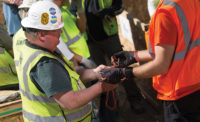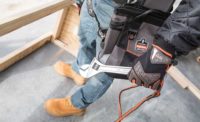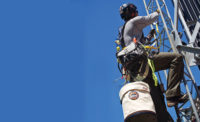Falling objects can be a fatal threat

According to the Bureau of Labor Statistics, in 2011 there were 219 fatalities from being struck by a falling object or equipment in the United States, which accounted for approximately five percent of all workplace fatalities.
The numbers don’t lie.
Dropped objects are a serious concern that can put a workforce at risk and result in lost productivity. Whether in the worker’s hand or idle on the work surface, a dangerous dropped object situation can happen without notice. Results can range from inconvenience/loss of productivity to life-altering injury or death.
Other negative results of dropped objects include the cost of damages to the dropped object itself, an object it impacts below or both. A worker drops a $1,200 laser alignment device 60 meters onto the hood of a brand new company F-150. Houston, you’ve got an expensive and unnecessary problem.
But even if no damage or injury occurs from a dropped tool, a worker can lose hours of productivity by retrieving a mission critical tool, wasting time and money for the company.
Risks
Objects-at-heights safety involves the following key risks:
1) Untethered, unorganized objects at an aerial jobsite.
2) Improper transport of objects to and from an aerial jobsite.
When tools and gear are kept in unorganized, uncovered, un-closeable containers, or conversely, not kept in containers at all, there is a much higher likelihood of these objects falling while at height. Pulling a wrench from the bottom of a pile, a jolt of a scissor lift that projects a bag of bolts, or an accidental kick of a loose tool off the ledge are examples of everyday actions that can add to unpredictability of this situation. Additionally, cords, ropes and hoses that may line and/or cross walkways create heightened risk of worker trips and falls caused by loose items and movement from scurrying around to locate them.
Another serious concern is the hoisting of equipment to and from the elevated jobsite. When climbing, a worker must maintain three points of contact to the ladder or structure. Carrying a bag of tools in one hand makes it difficult for a worker to abide by this important safety precaution; not to mention having to awkwardly carry equipment up to a location or overloading equipment onto a belt or harness. Buckets are a common solution. However, without a top, one gust of wind can turn that bucket on its head — literally.
Focusing on zero drops
The UK-based DROPS (Dropped Object Prevention Scheme) Organization recently announced its expansion to include a North American Chapter. Founded in 1997, DROPS is focused on dropped object prevention, specifically throughout the oil and gas industry. Members of DROPS include more than 130 of the world’s leading operators, contractors, service companies and industry bodies working together with the ultimate goal of zero dropped objects in the workplace.
Their work starts with educating companies and workers on the costs of a dropped object — from monetary, to productivity, to death — and then providing recommended rules and solutions to reduce/eliminate risk. While they specifically address the oil and gas industry, the education and solutions provided by DROPS are beneficial to and can be applied at any aerial jobsite.
Regardless of shape or size, power or manual, bucket or bag, workers’ gear needs to be where the job is at. There are numerous options to ensure it gets and stays there safely. The first step is to identify the specific challenges for the job at hand and formulate a plan. The next step is to identify solutions to help workers stay safe and be more productive. Critical solutions include:
1) Safely organizing and tethering all objects at an aerial jobsite.
Using organizers to keep cords, hoses and ropes tied up prevents them from becoming trip hazards. Efforts made to tie tools off on a lanyard or tethering device will pay for themselves in eliminating damage to equipment, reducing lost productivity, and most critically preventing injury or death.
2) Safe and proper storage/transport of objects to and from an aerial jobsite.
Best practice is to cover or close a container when in transit or when not accessing contents to prevent dropped objects. Another important decision is whether to carry or hoist the container. If carrying, the container must allow the worker to maintain three points of contact. If this proves difficult, look for a container with versatile handles or belt/body attachment methods to free hands up for what matters most — keeping the worker on the structure! If the weight of the gear is too heavy for a worker to carry on his or her own, the decision should be to hoist the equipment. Finally, a proper safety solution should have a stated weight rating and a safety factor built into the product for added confidence.
As you can see, objects at heights are a very real safety hazard. Identifying and preparing solutions is mission critical to completing a full circle safety-at-heights plan. For more information on DROPS and their efforts, visit dropsonline.org.
Looking for a reprint of this article?
From high-res PDFs to custom plaques, order your copy today!





